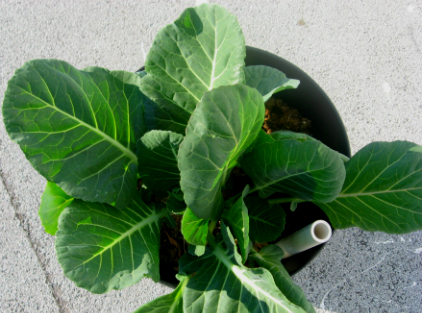Collards grow like a weed in these parts in the fall, through the
winter, and well into the spring; when it gets hot they typically bolt
and go to seed, making the leaves bitter.
They descended from wild cabbages that once grew in Europe.
They are a continuous crop, meaning that you can harvest the outer
leaves while the center continues to grow.
Collards can be seeded, or planted as starts. They prefer full to half
sun, rich fertile soil high in nitrogen, regular water, good drainage,
and organic mulch.
Plant them 1-foot apart, and expect them to yield for 6 months or
so if they are regularly harvested; increase the mulch when it warm
s in the spring to insulate the roots and deter blooming. If you get
any insect pests, expect small beetles or caterpillars.
A pot of collard greens is always referred to in the South as a “mess
of greens”, and the vitamin-rich, bacon-seasoned savory broth in
the bottom of the pot is called potlikker.
Traditionally the white plantation owners of the South consumed
the cooked and drained collard greens while the slave cooks, who
understood the high nutrient value of potlikker, saved the broth to
supplement their family’s diets.
Nothing is better for soaking up the potlikker than a hot piece of
crusty cornbread that’s been split down the middle and slathered
with sweet butter. The Potlikker and Cornpone Debate in February
and March of 1931 pitted Julian Harris, an editor at the Atlanta
Constitution, against Huey “The Kingfish” Long, the backwoods
populist governor and soon to be U.S. senator-elect from Louisiana.
The traditionalist Harris contended that Southerners must crumble
cornpone into potlikker, criticizing Long as an unrefined rube, who
contended that the cornpone should instead be dunked.
What started as a lighthearted fluff piece in the local paper turned
into a 23-day long news event that captivated the South (and much
of the rest of the nation, once it spread on the wires), and ended up
dealing with all sorts of cultural affairs, including race relations,
gender, social class, elitism, and regional chauvinism.
For what it’s worth, we prefer eating our potlikker-soaked chunk
of buttered cornbread with a spoon, so as not to lose any of that
precious elixir.
Mick’s Collard Greens
2 bunches of collard greens, washed well, central ribs removed,
chopped coarsely
¾ pound thick-sliced bacon, sliced thinly
1 large onion, halved and sliced
6 cloves garlic, minced
2 cups rich chicken stock
3 to 4 tablespoons Balsamic vinegar, to taste
2 to 3 tablespoons white sugar, to taste
1 to 2 teaspoons coarsely ground black pepper, to taste
Cornbread to soak up the potlikker
In a large stock pot with a lid, sauté the bacon over medium low
heat until the fat is rendered and the bacon golden brown.
Add the onion and sauté over medium heat until transparent, about
5 minutes. Add the garlic and sauté 30 seconds.
Add the collards and stir well, briefly sautéing the greens in the
bacon fat. Add the chicken stock, stir well, and place the lid on
the pot.
Allow the greens to cook down for about 20 minutes, stirring occas-
ionally, and add 3 tablespoons of the vinegar, 2 tablespoons of the
sugar, and 1 teaspoon of the black pepper.
Stir well for a minute and taste for seasonings. The broth should
be rich from the bacon and stock, there should be underlying salt-
iness from the bacon, and the vinegar and sugar should add a subtle
sweet-tart flavor.
Cook for another 5 minutes and taste again, adding more vinegar,
sugar, and pepper if desired. Do a final tasting for salt just before
service.
Serve in a bowl with plenty of the pottliker. A piece of crusty hot
buttered cornbread makes an excellent accompaniment. ❦
Mick Vann is a cookbook author, food writer, chef, restaurant consul-






